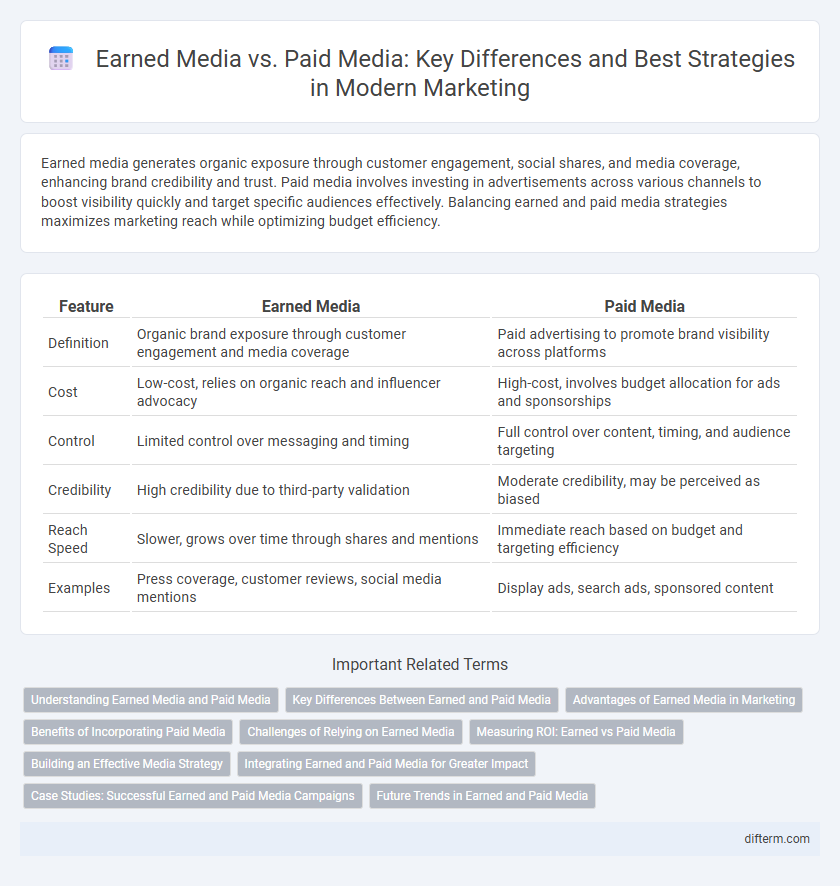Earned media generates organic exposure through customer engagement, social shares, and media coverage, enhancing brand credibility and trust. Paid media involves investing in advertisements across various channels to boost visibility quickly and target specific audiences effectively. Balancing earned and paid media strategies maximizes marketing reach while optimizing budget efficiency.
Table of Comparison
| Feature | Earned Media | Paid Media |
|---|---|---|
| Definition | Organic brand exposure through customer engagement and media coverage | Paid advertising to promote brand visibility across platforms |
| Cost | Low-cost, relies on organic reach and influencer advocacy | High-cost, involves budget allocation for ads and sponsorships |
| Control | Limited control over messaging and timing | Full control over content, timing, and audience targeting |
| Credibility | High credibility due to third-party validation | Moderate credibility, may be perceived as biased |
| Reach Speed | Slower, grows over time through shares and mentions | Immediate reach based on budget and targeting efficiency |
| Examples | Press coverage, customer reviews, social media mentions | Display ads, search ads, sponsored content |
Understanding Earned Media and Paid Media
Earned media refers to organic exposure gained through customer reviews, social media shares, and word-of-mouth, often driven by brand reputation and customer satisfaction. Paid media involves investing in advertisements such as pay-per-click (PPC), display ads, and sponsored content to directly reach target audiences and boost brand visibility. Understanding the distinct role of earned media in building trust versus paid media's ability to generate immediate traffic is crucial for optimizing marketing strategies.
Key Differences Between Earned and Paid Media
Earned media refers to organic exposure gained through word-of-mouth, social shares, and media coverage without direct payment, while paid media involves purchasing advertising space or sponsorships to promote content. Key differences include control, cost, and credibility--earned media is less controllable but often more trusted by audiences, whereas paid media offers precise targeting and immediate visibility. Metrics for earned media focus on engagement and reach, whereas paid media is tracked through impressions, clicks, and conversion rates.
Advantages of Earned Media in Marketing
Earned media generates authentic engagement by leveraging customer trust, resulting in higher credibility and organic reach compared to paid media. It typically drives more meaningful interactions through word-of-mouth, social shares, and media coverage, enhancing brand reputation without direct advertising costs. Marketers benefit from earned media's long-lasting impact on brand awareness and customer loyalty, making it a cost-effective strategy for sustainable growth.
Benefits of Incorporating Paid Media
Incorporating paid media amplifies brand visibility by precisely targeting specific demographics, ensuring faster audience reach compared to earned media. Paid campaigns provide measurable ROI through detailed analytics, allowing marketers to optimize strategies in real-time. Leveraging paid media also complements organic efforts, enhancing overall marketing impact and driving sustained customer engagement.
Challenges of Relying on Earned Media
Relying on earned media presents challenges such as unpredictable reach and lack of control over messaging compared to paid media. The effectiveness of earned media depends heavily on organic audience engagement and third-party endorsements, which can fluctuate and be difficult to measure accurately. Brands face risks of negative publicity and inconsistent brand representation when depending solely on earned media channels.
Measuring ROI: Earned vs Paid Media
Measuring ROI for earned media involves tracking organic engagement metrics such as shares, mentions, and sentiment analysis to evaluate brand reputation and customer trust, which often yield long-term value. Paid media ROI focuses on precise performance indicators like click-through rates, conversion rates, and cost per acquisition, enabling direct attribution to marketing spend and faster campaign optimization. Balancing both approaches requires integrating analytics tools to compare effectiveness in driving awareness, leads, and sales across diverse marketing channels.
Building an Effective Media Strategy
Earned media generates organic brand exposure through customer reviews, social shares, and media coverage, enhancing credibility and trust. Paid media involves targeted ads on platforms like Google Ads and social networks to drive immediate traffic and measurable ROI. Integrating earned and paid media optimizes reach, amplifies engagement, and strengthens overall marketing effectiveness.
Integrating Earned and Paid Media for Greater Impact
Integrating earned media and paid media amplifies brand visibility by combining the credibility of user-generated content with the targeted reach of paid advertising. Utilizing data-driven insights to align messaging across both channels enhances audience engagement and drives higher conversion rates. Strategic coordination ensures consistent brand storytelling, maximizing return on investment and fostering long-term customer loyalty.
Case Studies: Successful Earned and Paid Media Campaigns
Case studies reveal that successful earned media campaigns, such as Airbnb's user-generated content strategy, leverage authentic customer experiences to boost organic reach and brand credibility. Paid media campaigns like Nike's targeted social ads demonstrate precise audience segmentation and measurable ROI, driving immediate traffic and conversions. Integrating insights from both earned and paid media case studies enables marketers to create balanced campaigns that maximize brand exposure and engagement.
Future Trends in Earned and Paid Media
Emerging future trends in earned media emphasize the growing influence of authentic user-generated content and influencer partnerships that drive organic brand engagement without direct costs. Paid media continues to evolve with advancements in AI-driven targeting, programmatic advertising, and personalized ad experiences to maximize ROI and consumer relevance. Integration of earned and paid media strategies through data analytics and cross-channel marketing platforms is expected to enhance campaign effectiveness and real-time audience insights.
Earned Media vs Paid Media Infographic

 difterm.com
difterm.com